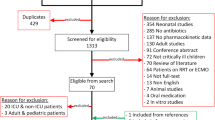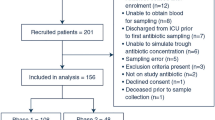Abstract
Optimising antibiotic use has become increasingly important due to the rise of bacterial resistance in pathogens detected in critically ill children. Additionally, many critically ill children are receiving subtherapeutic antibiotic dosages. Determining the best antibiotic, dosage, duration and route of administration in these children relies largely on clinicians’ expertise, as limited guidance is available. Using pharmacokinetic data and implementing antibiotic stewardship programmes to collect, analyse and share information are options for improving antibiotic optimisation in critically ill children.
Similar content being viewed by others
References
Willems J, Hermans E, Schelstraete P, et al. Optimizing the use of antibiotic agents in the pediatric intensive care unit: a narrative review. Paediatr Drugs. 2020;23(1):39–53.
Hartman SJF, Brüggemann RJ, Orriëns L, et al. Pharmacokinetics and target attainment of antibiotics in critically ill children: a systematic review of current literature. Clin Pharmacokinet. 2019;59(2):173–205.
World Health Organization. Global action plan on antimicrobial resistance. 2015. https://www.who.int/. Accessed 6 May 2022.
Gerber JS, Jackson MA, Tamma PD, et al. Antibiotic stewardship in pediatrics. Pediatrics. 2020;147(1):e2020040295.
Johnson I, Banks V. Antibiotic stewardship in critical care. BJA Educ. 2017;17(4):111–6.
Bruns N, Dohna-Schwake C. Antibiotics in critically ill children-a narrative review on different aspects of a rational approach. Pediatr Res. 2022;91(2):440–6.
Craig JC, Williams GJ, Jones M, et al. The accuracy of clinical symptoms and signs for the diagnosis of serious bacterial infection in young febrile children: prospective cohort study of 15 781 febrile illnesses. BMJ. 2010;340:c1594.
Nair H, Simões EAF, Rudan I, et al. Global and regional burden of hospital admissions for severe acute lower respiratory infections in young children in 2010: a systematic analysis. Lancet. 2013;381(9875):1380–90.
Morgan AJ, Glossop AJ. Severe community-acquired pneumonia. 2016. https://www.bjaed.org/. Accessed 6 May 2022.
Kowalska-Krochmai B, Dudek-Wicher R. The minimum inhibitory concentration of antibiotics: methods, interpretation, clinical relevance. Pathogens. 2021;10(2):165.
The British Society for Antimicrobial Chemistry. Resistance surveillance project. http://bsacsurv.org/. Accessed 6 May 2022.
European committee on antimicrobial susceptibility testing. Clinical breakpoints - breakpoints and guidance. 2022. https://www.eucast.org/. Accessed 6 May 2022.
Roberts JA, Lipman J. Pharmacokinetic issues for antibiotics in the critically ill patient. Crit Care Med. 2009;37(3):840–51.
McMullan BJ, Andresen D, Blyth CC, et al. Antibiotic duration and timing of the switch from intravenous to oral route for bacterial infections in children: systematic review and guidelines. Lancet Infect Dis. 2016;16(8):e139–52.
Author information
Authors and Affiliations
Corresponding author
Ethics declarations
Funding
The preparation of this review was not supported by any external funding.
Authorship and conflict of interest
C. Fenton, a contracted employee of Adis International Ltd/Springer Nature, and A. Lee, a salaried employee of Adis International Ltd/Springer Nature, declare no relevant conflicts of interest. All authors contributed to the review and are responsible for the article content.
Ethics approval, Consent to participate, Consent for publication, Availability of data and material, Code availability
Not applicable.
Rights and permissions
About this article
Cite this article
Fenton, C., Lee, A. Use available data to optimise antibiotic use in critically ill children. Drugs Ther Perspect 38, 322–328 (2022). https://doi.org/10.1007/s40267-022-00924-8
Accepted:
Published:
Issue Date:
DOI: https://doi.org/10.1007/s40267-022-00924-8




